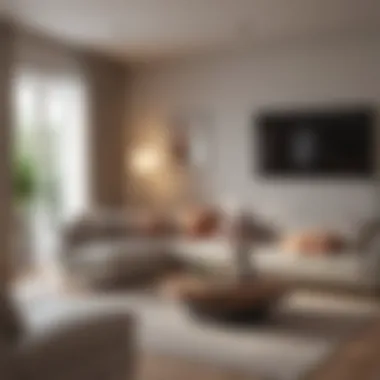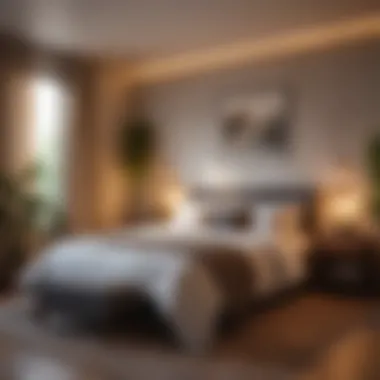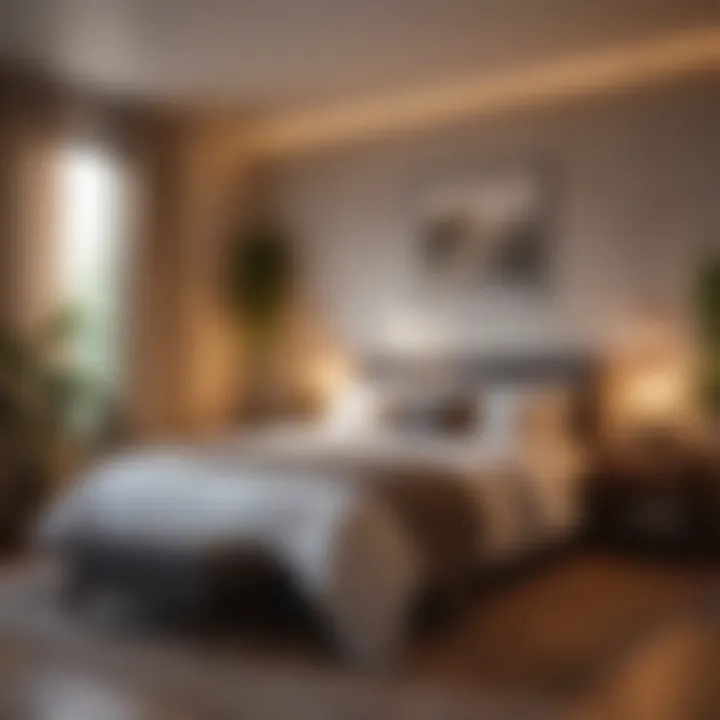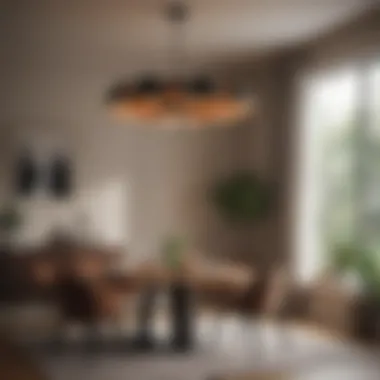Illuminate Your Space: Choosing the Perfect Lighting


Intro
Selecting the right lighting is more than just choosing a bulb or a fixture. The light in your room can change the feel and functionality of the space. It is essential to understand the different types of lighting available and how they serve various purposes. Given the importance of light on mood and productivity, this guide will explore effective lighting strategies to help homeowners and design enthusiasts make informed choices.
Design Inspiration
Current Trends in Interior Design
In recent years, interior design has seen a shift towards minimalism combined with warmth. People prefer lighting that enhances the structure of their room and complements personal style. Recessed lighting has become popular for its clean, uncluttered appearance. Pendant lights serve as statement pieces in kitchens and dining areas, providing functionality and aesthetic appeal.
Smart lighting solutions are also on the rise. Systems that can be controlled via smartphones allow users to adjust brightness according to the time of day or specific activities.
Color Schemes and Palette Ideas
The color of light can change how a room appears. Warm colors provide a cozy atmosphere, while cooler tones create a more vibrant, energetic feel. When selecting lighting, consider how it interacts with your color palette.
- Warm White (2700K-3000K): Ideal for living rooms and bedrooms. It promotes relaxation.
- Neutral White (3500K-4100K): Good for kitchens and offices. It enhances focus and clarity.
- Cool White (5000K-6500K): Works well for task lighting. It increases alertness.
By understanding these nuances, homeowners can create a harmonious atmosphere in their spaces.
"Lighting is the silent architecture of a room. It shapes our experiences and influences our behavior."
Next, we will explore practical tips for implementing effective lighting strategies.
Understanding the Role of Light in Interior Design
Light plays a critical role in shaping interior spaces. Often, it is underestimated how significant the right lighting can be to a room's functionality and aesthetic value. Effective lighting can enhance the clarity of colors and textures, contributing to the overall ambiance. Therefore, understanding the role of light in interior design is essential for creating not just beautiful spaces, but also practical ones.
When designing interiors, lighting should be a top consideration. It influences mood, highlights architectural features, and creates a sense of depth. A well-lit space feels more inviting and comfortable.
In addition, lighting should complement the intended use of the room. For instance, softer lighting might be suitable for a bedroom to promote relaxation, while brighter lights are ideal for workspaces that require focus. This strategic use of light can elevate design and experience in any room.
The Importance of Lighting
Lighting is a foundational element in interior design. Without it, spaces can feel stark or claustrophobic. Lights can create focal points within the room, guiding the eye and enhancing visual interest. Also, the right type of lighting can support the functionality of a space. Each room has a unique purpose, and lighting must align with that to maximize both comfort and practical use.
Types of Lighting
Understanding the different typologies of lighting is crucial for a comprehensive approach to interior design. Primarily, lighting can be categorized into three types: ambient lighting, task lighting, and accent lighting. Each one serves a distinct purpose, allowing for a thoughtful design approach.
Ambient Lighting
Ambient lighting provides general illumination to a room. It acts as the primary source of light, allowing occupants to navigate the space with ease. A key characteristic of ambient lighting is its ability to create an overall atmosphere. Common fixtures include ceiling lights, chandeliers, and wall-mounted fixtures.
The benefit of ambient lighting lies in its versatility. It can adapt to different room types and uses, providing a cohesive base layer of light. However, if the light is too harsh, it may create discomfort. Therefore, selecting the right intensity is crucial.
Task Lighting
Task lighting is specifically designed to facilitate activities that require focused light. This includes reading, cooking, or working. A main feature of task lighting is its directionality, which allows it to illuminate specific areas without flooding the whole room with light.
This type of lighting is particularly beneficial. It enhances visibility and reduces eye strain, making spaces more functional. Examples include desk lamps, under-cabinet lights, and pendant lights over work areas. However, overreliance on task lighting without ambient support can lead to uneven illumination in a space.
Accent Lighting
Accent lighting adds drama and interest by highlighting specific elements within a space. This could be artwork, architectural details, or other decorative features. A distinct aspect of accent lighting is that it is typically much brighter than ambient lighting, creating contrast and drawing attention to focal points.
This type is advantageous for creating mood and enhancing design. However, it serves more of a decorative purpose than functional. Thus, it should not be the sole light source in a room. Careful planning ensures that accent lighting complements other layers of light for effective balance.
Defining Your Needs
Understanding your specific needs is a crucial step before embarking on the journey of selecting lighting for any room. The decisions you make about lighting can significantly influence both the functionality and aesthetic of the space. Light serves not just as illumination but as a vital element that defines mood, enhances décor, and complements activities. Recognizing the purpose of the room and your personal preferences will guide you toward the types of lighting solutions that will work best for you.
Assessing Room Functionality
Every room in your home serves a specific function, and this functionality should dictate your lighting choices. Consider how the room will be used. For instance, in a kitchen, task lighting is essential for safety and efficiency while preparing meals. Conversely, a living room might benefit from softer ambient lighting to create a relaxed atmosphere.
You need to consider aspects such as:
- Activities: Will the space be used for reading, cooking, or entertaining?
- Size and shape: A smaller room may require layered lighting to avoid feeling cramped.
- Natural light: Assess how much daylight enters the room and plan accordingly. Some rooms may not need as much artificial light if they receive ample sunlight during the day.
Keeping these factors in mind will assist in creating a well-lit environment that supports the intended activities, ensuring that the lighting complements the practical use of the room.
Considering User Preferences
User preferences tend to vary widely and are an essential consideration when defining your lighting needs. Think about who will use the space and their habits. For people who enjoy working from home, bright, focused task lighting may be necessary. Meanwhile, families with children may prioritize durable fixtures that can withstand wear and tear.
Some points to ponder regarding preferences include:
- Lighting styles: Do you prefer modern fixtures, or do you lean towards more traditional styles?
- Color temperatures: Are you drawn to warm tones that create a cozy feel, or do you prefer the crispness of cool lighting?
- Control and flexibility: Do you want the ability to adjust brightness and color with smart lighting options to fit different moods?
Considering these preferences ensures that the light you choose not only serves its practical function but also resonates personally with the inhabitants. Ultimately, harmonizing room functionality with user preferences can elevate your space, enhancing comfort and enjoyment.
Exploring Design Styles
Exploring design styles is a crucial aspect of selecting lighting for various spaces. Each style has unique characteristics that influence the choice of lighting. Understanding these styles allows you to create an environment that aligns with your aesthetic preferences and functional needs. The right lighting can enhance the overall design, drawing attention to important features and setting the mood for the room. When considering design styles, factors such as scale, color schemes, and material choices play a significant role in achieving harmony within the space.


Contemporary Trends
Contemporary trends in lighting design refer to the most current styles and innovations in the marketplace. This often encompasses minimalistic fixtures, energy-efficient LED lighting, and smart technology applications. A key aspect is the emphasis on clean lines and simplicity. These designs tend to integrate seamlessly with modern decor, providing both functionality and aesthetic appeal.
The use of smart lighting solutions is notable in contemporary design. Homeowners can control brightness and color with ease, adapting the ambiance according to their needs. This flexibility enhances the usability of the space. Notable brands that explore this trend include Philips Hue and LIFX. Consider showcasing sculptural lighting fixtures that serve as statement pieces while still blending with the overall environment.
Classic Inspirations
Classic inspirations draw from historical designs that have timeless appeal. This style often includes ornate fixtures, chandeliers, and warm hues. When selecting lighting inspired by classic themes, the emphasis is on elegance and craftsmanship.
Key elements may include:
- Chandeliers: These fixtures can create a grand focal point, especially in dining rooms and entryways.
- Wall Sconces: These help in creating layers of light while also serving decorative purposes.
- Table Lamps: Classic styles often feature rich materials like crystal or brass.
Incorporating classic lighting into a modern space can create a striking contrast. This approach pays tribute to tradition while also allowing for new interpretations. It is essential to select pieces that convey the desired elegance without overwhelming the room's design.
Eclectic Approaches
Eclectic approaches in lighting design offer the freedom to combine various styles and elements. This could mean mixing vintage with contemporary pieces or artistic fixtures alongside minimalist décor. The key is to create a unique expression suited to individual taste.
Some considerations:
- Combining Textures: Use a variety of materials such as wood, metal, and glass for a more layered look.
- Varied Color Palettes: Don't shy away from bold color choices. This can add personality and vibrancy to the space.
- Unique Arrangements: Experimenting with different heights and placements of fixtures can lead to a visually interesting environment.
Eclectic lighting can reflect personal stories or cultural influences. It serves not only to illuminate but also to spark conversation. Careful consideration ensures that the various elements come together in a cohesive way.
Selecting the right lighting style can significantly enhance the ambiance of your home. It involves understanding your personal preferences as well as how each light fixture complements the overall design.
Color Temperature and its Impact
Understanding color temperature is crucial in achieving the right ambiance in a space. It can affect not only the aesthetic appeal of a room, but also the mood and functionality. Light can be categorized into three main types: warm, cool, and neutral. Each type has its own impact on the perception of space, and making the right choice can greatly enhance your room's overall character.
Understanding Color Temperature
Color temperature is measured in Kelvin (K). The lower the number, the warmer the light appears. For instance, lights at around 2700K to 3000K emit a soft yellow hue, while those around 4000K to 5000K give off a more neutral tone. Finally, lights that exceed 5000K appear bluish. This concept is essential for homeowners. The right color temperature can create a welcoming atmosphere or foster an environment conducive to productivity.
Choosing the Right Color for Your Space
Warm Light
Warm light, typically ranging from 2700K to 3000K, is favored for its ability to create intimacy. This light adds a golden glow that can make spaces feel cozy and inviting. It is a beneficial choice for living rooms, dining areas, and bedrooms, where comfort is prioritized.
One significant characteristic of warm light is its ability to enhance the richness of colors in a room. This results in a space that feels both calming and engaging. However, overusing warm light can lead to a space that feels too soft, detracting from focus in areas designed for productivity.
Cool Light
Cool light ranges from 4000K to 5000K, leaning towards a white hue. This light is often described as crisp and bright. In workspaces and kitchens, cool light can be an excellent option, fostering alertness and concentration. The bright nature of cool light promotes clarity and can aid in tasks requiring attention to detail.
Nevertheless, while cool light may enhance focus, extensive use may lead to a sterile feel. It can sometimes strip a room of warmth, making it less inviting. Knowing when to use cool light is vital.
Neutral Options
Neutral light, typically hovering around 3500K to 4100K, serves as a middle ground between warm and cool. It is versatile and adapts well to various settings. The balance allows neutral light to complement a multitude of colors and materials, making it suitable for almost any room.
The unique feature of neutral light is its adaptability. It blends well with both warm and cool elements, allowing for creative flexibility in design. However, some may find it lacks the distinct warmth or crispness that certain spaces might require.
Choosing the right color temperature affects everything from the mood of the room to the functionality of the tasks performed within it.
In summary, the selection of color temperature plays a vital role in interior design. Understanding the nuances of warm, cool, and neutral light is essential for creating an environment that meets your functional and aesthetic needs.
Practical Lighting Solutions
Practical lighting solutions are essential for creating a functional and visually appealing environment. This section delves into various fixtures suitable for diverse settings, emphasizing both form and function. Adopting the right lighting can enhance the quality of life in any space, making it not only more livable but also profoundly inviting. When selecting fixtures, it is important to balance aesthetics with utility, ensuring that each element serves a clear purpose while contributing to the overall design.
Choosing Fixtures
Choosing the right lighting fixtures plays a crucial role. There are several types of lighting solutions that serve different purposes. Three key categories often recommended include ceiling lights, wall sconces, and table and floor lamps.
Ceiling Lights
Ceiling lights are a popular choice for many homeowners. Their main contribution is to provide broad illumination, making them effective in large spaces. The key characteristic of ceiling lights is their ability to disperse light evenly throughout the room. This makes them suitable for dining rooms, living areas, and kitchens where general lighting is necessary.
A unique feature of ceiling lights is their variety; from flush mounts to chandeliers, they offer numerous styles to match any design theme. However, one disadvantage can be their potential to create harsh lighting if not chosen correctly. Thus, it's important to select fixtures that provide adequate brightness without overwhelming the space.
Wall Sconces
Wall sconces are another effective practical lighting solution. Their standout feature is the ability to cast light upwards or downwards, thus creating visual interest on walls. This makes them particularly effective in hallways or near artwork, enhancing the aesthetic appeal of the space.
Additionally, wall sconces offer flexible placement options. They can act as decorative features while adding necessary illumination. However, they are not as effective for general lighting when compared to ceiling lights. They should be used in conjunction with other fixtures to create a balanced lighting scheme.
Table and Floor Lamps
Table and floor lamps are versatile fixtures that provide localized lighting. Their primary role is to allow for task lighting, making them ideal for reading nooks or workspaces. The key characteristic of these lamps is their mobility; they can be moved to different locations as needed.
Table lamps can complement furniture, while floor lamps can make bold statements in a room. A unique advantage lies in their ability to introduce warmth and character to a space. Yet, the downside is that they may not provide sufficient lighting for broader areas on their own. To maximize their effect, they should be combined with other light sources.


Utilizing Smart Lighting
In recent years, smart lighting has grown significantly. This approach provides homeowners with the ability to control their lighting easily. Using apps and voice commands can adjust brightness and color temperature instantly. Benefits include energy efficiency and the capacity to tailor lighting to specific occasions.
"Smart lighting allows for easy adjustments, making any atmosphere suitable for various events."
Homeowners considering practical lighting solutions should not overlook the potential of technological advancements. By integrating multiple sources of light, along with smart technology, it is possible to achieve the perfect ambiance in any room.
Through careful consideration and selection of lighting fixtures, the overall atmosphere and functionality of a room can be significantly enhanced. Choosing the right combinations, whether through ceiling lights, wall sconces, or lamps, ensures that all areas are well-lit and inviting. Embracing smart solutions adds further customization that elevates the living experience.
Layering Light Effectively
Layering light is a fundamental aspect of designing a well-lit room. It involves the strategic use of different lighting types and sources to create depth, visual interest, and functionality. Understanding how to layer light can significantly enhance the atmosphere of any space. This approach allows you to adapt your lighting to suit various activities and moods throughout the day, making it an essential strategy for homeowners and design enthusiasts.
Combining Different Light Sources
Combining light sources is crucial in achieving an effective lighting design. Three main types of lighting contribute to this layering effect: ambient, task, and accent lighting.
- Ambient Lighting provides the overall illumination for a space. Ceiling fixtures, wall-mounted lights, and natural light from windows are common sources.
- Task Lighting focuses on specific areas where activities occur. Examples include desk lamps for reading or under-cabinet lights in a kitchen.
- Accent Lighting creates visual emphasis on specific features, like artwork or architectural details.
When these lighting types are combined, they serve different purposes while contributing to a cohesive look. For instance, a living room may utilize ambient lighting from a chandelier, task lighting from table lamps, and accent lighting from wall sconces. This variety not only enhances functionality but also adds depth and ambiance, allowing the room to transform based on the time of day or the occasion.
Adjusting Brightness Levels
Adjusting brightness levels is an important consideration in layered lighting. Different activities require varying levels of light. For instance, bright light can energize spaces during the day, while softer light is more relaxing in the evening.
Utilizing dimmers is a practical solution for controlling brightness. Dimmers can adjust the intensity of light from a fixture, allowing for custom settings that suit the mood or task at hand. For example, during a dinner party, a softer light may create a warm atmosphere, while a brighter setting is better for cleaning or organizing.
Moreover, smart lighting solutions can offer even more flexibility. These systems allow you to change the brightness and color temperature through an app or voice command. This adaptability is particularly beneficial in multi-purpose rooms where activities vary from reading to entertaining.
"Layered lighting not only improves the aesthetics of a space but also significantly impacts the functionality."
The Psychological Effects of Lighting
Lighting does more than simply illuminate a space; it profoundly influences our emotions and behaviors. Understanding the psychological effects of lighting can empower homeowners and designers to create environments that enhance well-being and productivity. Light is a tool that shapes mood, affects perception, and modifies our experiences within a space. This is vital for effective interior design and can guide strategic decisions about lighting options.
Impact on Mood
Lighting affects mood in significant ways. Bright light tends to energize and uplift individuals, while dim light can create a sense of calm and relaxation. Different types of light can evoke various emotions. For instance, warm light can foster intimacy and comfort, which is ideal for living areas or bedrooms. On the other hand, cooler light can enhance focus and alertness, making it a good choice for workspaces or study areas.
Factors to Consider:
- Color Temperature: Warmer tones, such as those provided by incandescent bulbs, can induce feelings of warmth and comfort.
- Intensity: Higher light levels increase alertness, while lower intensity is more soothing.
Applications:
- Use soft, warm lighting in areas meant for relaxation, like reading nooks.
- Incorporate brighter, cooler lighting in places where focus is needed, such as offices or kitchens.
Effect on Productivity
Lighting plays a critical role in productivity. Workspaces benefit greatly from effective lighting design. Bright, even light can reduce eye strain and fatigue. Appropriate lighting enhances cognitive performance, enabling better concentration and efficiency.
Considerations for Productivity:
- Task Lighting: Specific tasks require different light intensities. For example, tasks like reading or crafting benefit from focused task lighting.
- Natural Light: Exposure to daylight boosts mood and reduces fatigue. It's beneficial to maximize natural sunlight in work environments.
Recommendations:
- In an office, opt for adjustable LED lighting to match the task at hand.
- Position desks near windows to take advantage of natural light.
Proper lighting not only enhances aesthetic appeal; it fundamentally contributes to mental states and work efficiency.
Understanding the psychological effects of lighting allows for thoughtful choices in design that promote positivity and productivity.
Common Mistakes to Avoid
Selecting the right lighting for your space requires a thoughtful approach. It is easy to make errors when faced with many options. Understanding common mistakes can enhance your space's functionality and aesthetic appeal.
Several pitfalls can significantly affect the effectiveness of your lighting choices. By recognizing these, you can create a more balanced atmosphere that caters to your needs. Avoiding these mistakes can also save you time and money in the long run. Thus, it is essential to be mindful of these factors as you design your lighting layout.
Overloading a Space with Light
One frequent error is overloading a room with too much light. This can lead to harshness, glare, and discomfort. When there is excessive brightness, it can cause an unsettling environment. To prevent this, consider the purpose of each room. For example, a living room can benefit from softer, ambient lighting that encourages relaxation, while a kitchen or workspace may need brighter task lighting for functionality.
Here are several aspects to consider:
- Layering Light Sources: Use a mix of different lighting types to achieve balance. Combining ambient, task, and accent lighting creates depth.
- Brightness Levels: Use dimmers where possible. Adjusting brightness to suit different time of day or activities can enhance comfort.
- Light Fixtures: Select fixtures that emit the appropriate intensity and direction of light. This can prevent a room from feeling overexposed.
Ignoring Natural Light
Another common mistake is ignoring the presence of natural light in your space. Natural light significantly impacts the atmosphere and mood of a room. Relying solely on artificial lighting can create an imbalanced environment.
Here are key considerations:
- Maximize Daylight: Identify windows and openings where light comes in. Use sheer curtains that diffuse light without blocking it.
- Reflective Surfaces: Incorporate mirrors or glossy surfaces to bounce natural light around the room. This can make the space feel bigger and more welcoming.
- Complementary Lighting: Use artificial lighting to supplement natural sources rather than overpower them. This often means avoiding overly bright fixtures during the day when natural light is ample.


Ultimately, integrating natural light into your design will enrich the experience of your room. Achieving a balance between artificial and natural light will ensure your space is inviting and functional.
"Great lighting makes all the difference in how we live and work in our spaces."
Implementing Lighting Solutions
Implementing lighting solutions is an essential aspect of interior design. This section focuses on how to effectively bring your lighting vision to fruition while maintaining a balance between functionality and aesthetic appeal. The right lighting can enhance a room's atmosphere, improve its usability, and even influence the overall mood of the space. However, to achieve this, proper planning and execution are crucial.
Planning Your Layout
When planning your layout, consider the purpose of each room. Each area typically serves a specific function that should be complemented by appropriate lighting. Start by mapping out where you will place fixtures based on the activities that will occur in that space. For instance, in a living room, ambient light may be needed for general tasks, while task lighting will enhance reading corners.
Incorporate layers of light by combining ambient, task, and accent lighting. Ambient lighting forms the foundation and creates a feeling of spaciousness. Task lighting should be directed toward work areas, while accent lighting adds depth and highlights key design features.
To effectively plan your layout:
- Create a lighting plan: Draft a sketch of your room indicating where different light fixtures will be placed.
- Identify power sources: Ensure that there are adequate electrical outlets in the planned locations.
- Test your layout: Use temporary light sources to visualise how various placements affect the space.
Installing and Adjusting Fixtures
Once the planning stage is completed, the installation of fixtures follows. This phase requires attention to detail and safety considerations. Ensure you follow relevant electrical codes and regulations. When installing fixtures, consider their height and orientation, as these factors can greatly affect how light disperses throughout the room.
It is beneficial to use adjustable fixtures whenever possible. For example, pendant lights can be hung at variable heights, adapting to the room's function or aesthetic needs. Overhead lights should be positioned at an appropriate height to minimize glare.
After installation, adjusting fixtures becomes important for achieving the desired light output. Take time to test the brightness levels by dimming or brightening as needed. Here are some quick ways to check:
- Walk through the space: Observe how the lighting interacts with walls and furniture.
- Review shadow effects: Ensure no unwanted shadows detract from functionality.
Remember, the goal of implementing lighting solutions is to create an environment that is both functional and inviting. Proper execution will contribute to a harmonious space that reflects personal style while meeting practical needs.
By following these guidelines, homeowners and design enthusiasts can ensure that their lighting solutions are well-integrated into their living spaces.
Sustainability in Lighting Choices
Sustainability in lighting choices is increasingly important in today’s world, where environmental concerns are at the forefront. The manner in which we illuminate our homes can greatly influence not only our energy consumption but also our overall carbon footprint. As more homeowners and design enthusiasts prioritize eco-friendliness, understanding sustainable lighting options can create significant benefits. These include reduced energy costs, lower environmental impact, and improved quality of living spaces.
Incorporating sustainability into your lighting choices begins with an awareness of your energy consumption. Traditional incandescent bulbs, while offering a warm glow, use a substantial amount of energy and have a short lifespan. In contrast, energy-efficient options have demonstrated both longevity and reduced power usage, aligning perfectly with sustainability objectives. Choosing the right types of bulbs and fixtures can lead to meaningful changes in energy use.
Energy-Efficient Options
There are numerous energy-efficient options available today. Compact fluorescent lamps (CFLs) and light-emitting diodes (LEDs) are prominent examples. Each of these alternatives not only consumes less energy than traditional bulbs but also lasts significantly longer.
- CFLs: These bulbs can use up to 75% less energy compared to traditional incandescent bulbs. Their lifespan typically ranges from 7,000 to 15,000 hours, making them a practical choice.
- LEDs: This is often seen as the most energy-efficient lighting solution. They consume about 80% less energy than incandescent bulbs and can last up to 25,000 hours or more.
Both CFLs and LEDs contribute to a reduction in energy costs while improving your home's ecological status. Furthermore, when selecting fixtures, consider those that are designed for efficiency. Fixtures with integrated LEDs or those that improve the distribution of light can enhance the overall effectiveness of your lighting scheme while minimizing waste.
Environmental Impact of Lighting
The environmental impact of lighting extends far beyond your energy bills. The manufacturing, disposal, and operation of lighting sources have implications for the planet.
- Manufacturing: The production of traditional light bulbs requires substantial materials and energy. In contrast, the production of LEDs poses fewer environmental challenges due to their longevity, reducing the demand for frequent replacements.
- Disposal: Many traditional bulbs, especially fluorescents, contain materials that can be harmful when improperly disposed of. LEDs, on the other hand, are safer to dispose of, but still require responsible recycling to prevent environmental harm.
The reduction of energy usage from energy-efficient lighting translates directly into lower greenhouse gas emissions. As society shifts toward a more sustainable future, the choices made in lighting can significantly contribute to environmental conservation efforts.
"Making informed choices about lighting not only enhances our living spaces, but it also reflects our commitment to a sustainable future."
Future Trends in Lighting Design
The evolution of lighting design is shaped by technological advances and shifts in consumer preferences. As spaces become more multifunctional, the importance of future trends in lighting design cannot be understated. It allows homeowners and designers alike to stay ahead in creating comfortable, energy-efficient, and aesthetically pleasing environments. By understanding upcoming innovations and styles, one can enhance the functionality of a room while also meeting contemporary aesthetic demands.
Innovations in Lighting Technology
Recent years have seen notable advancements in lighting technology, primarily driven by the demand for energy efficiency and personalization. LED lighting has become the standard due to its long lifespan and low energy consumption. However, newer developments are expanding beyond simple efficiency. For instance, smart lighting systems like Philips Hue and LIFX offer customizable options, allowing users to adjust brightness and color via mobile apps or voice assistants.
- Smart Sensors: Lighting that automatically adjusts based on occupancy or natural light reduces unnecessary energy usage. These systems integrate seamlessly with security measures as well, enhancing home safety.
- Human-Centric Lighting: This trend focuses on aligning indoor lighting with the body's natural circadian rhythms to improve well-being and productivity. Research shows that proper lighting can significantly enhance mood and focus.
- Integration with Home Automation: As homes become smarter, lighting will increasingly link with other systems like heating and cooling, creating a unified environment controlled through central platforms.
Smart lighting is not just about efficiency, but also about creating an adaptable living space that enhances the overall quality of life.
Emerging Styles
The aesthetic side of lighting design is equally significant, reflecting broader trends in interior design and individual expression. Certain styles are becoming prevalent:
- Minimalist Designs: Simple, clean lines characterize fixtures that emphasize functionality without unnecessary embellishment. This trend aligns well with modern, open-concept spaces.
- Biophilic Design: Lighting that mimics natural elements is gaining popularity. Using fixtures that resemble organic shapes or incorporate natural materials helps to create a more soothing atmosphere.
- Vintage and Retro Influences: There is a resurgence of interest in vintage-style fixtures, particularly Edison bulbs and industrial designs. These not only add character to spaces but also offer a touch of nostalgia, appealing to a love for past aesthetics in modern settings.
- Colorful Lighting: There is a growing trend towards using colored lights to create ambiance. This can be as simple as installing colored LEDs or layering natural light with accents in bold colors.
Adapting to these emerging styles allows for a personal touch in lighting choices while also considering the practicality that modern spaces require.
The End
The conclusion of this article wraps up the fundamental aspects of selecting the right light for any room, emphasizing its significance in enhancing both functionality and aesthetics. As we have explored, lighting is not merely a practical consideration; it creates ambiance, influences mood, and affects productivity. This final section encourages readers to reflect on the diverse elements discussed throughout the article — from understanding types of lighting to recognizing the impact of color temperature.
By integrating the right lighting solutions, homeowners and interior design enthusiasts can achieve a space that is not only visually appealing but also practical for different activities. It is vital to remember that each room serves a unique function, requiring specific lighting strategies tailored to those needs. Moreover, engaging with smart lighting options presents an opportunity for users to adapt their spaces seamlessly throughout the day, adjusting to varying requirements.
In summary, the careful selection of light sources and fixtures significantly contributes to the overall satisfaction and comfort of a living or working environment. This is especially relevant for those who frequently host gatherings or engage in tasks that demand a lively and productive atmosphere. The benefits extend beyond visual aesthetics; they encompass well-being and efficiency, making the consideration of light an essential part of interior design.
Recap of Key Points
- Understanding the Role of Lighting: Proper lighting selections enhance the overall design and functionality of a space.
- Assessing needs: Determine the purpose of each room to establish suitable lighting solutions.
- Types of Lighting: Familiarize with ambient, task, and accent lighting for layered effects.
- Color Temperature: Choose appropriate color temperatures that match the room's atmosphere.
- Sustainability: Look into energy-efficient lighting options which have minimal environmental impacts.
- Emerging Trends: Stay updated with technological innovations shaping the future of lighting design.
- Avoiding Common Mistakes: Learn to balance natural and artificial lighting.
Final Thoughts on Lighting
Lighting is a critical element in home design that goes beyond merely illuminating space. It is about creating an environment that invites comfort, promotes activity, and encourages relaxation when needed. Each decision regarding fixtures and light sources should reflect the characteristics of both the individual and the space itself.
As the demands of our lifestyles evolve, so do our lighting needs. It is wise to think critically about how lighting influences daily experiences. Whether you are a gardening aficionado looking to highlight plant life or a party host aiming to set the perfect mood, the right lighting can transform any space. This comprehensive understanding equips readers with the tools to make informed choices, ensuring that every room can shine brightly in its own unique way.



